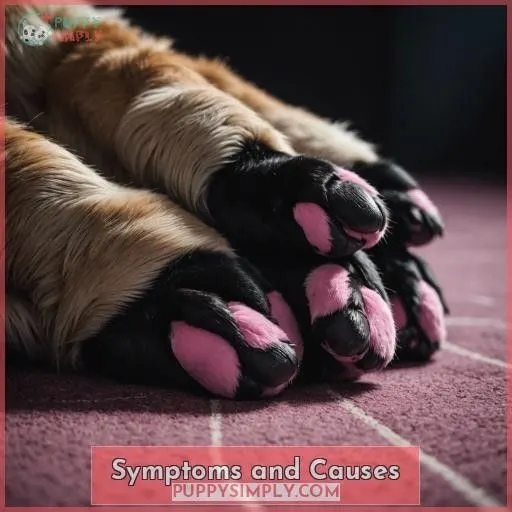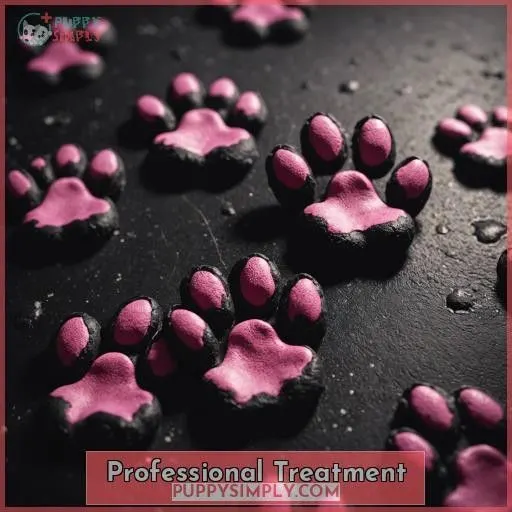This site is supported by our readers. We may earn a commission, at no cost to you, if you purchase through links.
 Your dog’s paws appear pink and black due to natural pigmentation or underlying health issues.
Your dog’s paws appear pink and black due to natural pigmentation or underlying health issues.
Harmless causes include breed characteristics, puppy paw development, and shedding of the outer layer.
However, allergies, infections, or autoimmune diseases can also cause inflamed, itchy paws.
Address symptoms like excessive licking by giving appropriate antihistamine dosages based on your dog’s size.
For persistent issues, consult your veterinarian, who may prescribe medicated creams or oral medications targeting the root cause.
Proper paw care and early intervention guarantee your furry friend’s comfort.
If these potential reasons intrigue you, let’s explore further.
Table Of Contents
Key Takeaways
- Natural pigmentation, puppy paw development, and shedding of the outer layer can cause a harmless marbled appearance on a dog’s paws.
- Allergies, infections, or autoimmune diseases can lead to inflamed, itchy paws that appear pink and raw.
- Administering appropriate antihistamine dosages based on the dog’s size can help address allergy-related paw issues.
- Consulting a veterinarian is recommended for persistent paw problems, as they can provide a proper diagnosis and prescribe targeted treatments.
Why Are My Dog’s Paws Pink and Black?
Your dog’s paws may appear pink and black due to natural pigmentation or shedding of the outer skin layer. Allergies or sensitive paws can also cause this coloration, which may require home treatment or a visit to the veterinarian.
Common Causes of Pink and Black Paws
Have you noticed your dog’s paw pads changing color, with parts turning pink and other areas remaining black? This marbled appearance is often caused by harmless factors like natural coloration, shedding of the outer layer, or simply being a puppy, but it can also signal potential issues like allergies or sensitive paws.
Natural Coloration
Some dog breeds with light-colored coats may naturally have a marbled or mottled appearance on their paw pads. This is a normal variation and not a cause for concern. Puppies are born with soft, pink or blackish paws that thicken and wear away with age, resulting in a marbled look.
Shedding of Outer Skin Layer
The outer layer of your dog’s paw pads may shed over time due to wear and tear on hard surfaces. This can leave the paws looking pink and black. Regular grooming, using a paw conditioner, and limiting exposure to debris can help protect your pup’s sensitive paws. Keep them clean and conditioned to prevent irritation.
| Paw Exfoliation | Paw Conditioning | Irritant Protection |
|---|---|---|
| Shedding of outer skin layer | Use a paw conditioner regularly | Avoid walking on hot pavement |
| Caused by wear on hard surfaces | Keeps paws moisturized and healthy | Keep paws clean after outdoor activities |
Puppy Paws
Puppies are born with soft, pink or blackish paw pads that thicken and wear away as they age, sometimes resulting in a marbled appearance. This natural coloration is common and not a cause for concern. However, sensitive puppy paws require extra care, like using dog boots or paw wax, to protect them from environmental hazards.
Allergies
Skin allergies can cause your dog’s paws to turn pink and black due to inflammation, redness, and excessive licking or chewing. To help, try:
- Wiping paws with a damp cloth after being outside
- Giving your dog an antihistamine like Allegra
- Using a soothing paw balm to keep paws moisturized
If symptoms persist, consult your veterinarian for stronger medication.
Sensitive Paws
Some dogs have thinner, more sensitive paw pads that can easily get irritated by cleaning products, rough surfaces, or environmental hazards. Keep their paws clean and use paw balms to condition them. Limit time on hot pavement and avoid contaminated areas. Regular grooming and inspecting for signs of infection or injury is key to maintaining healthy paws.
Symptoms and Causes
If you notice your dog’s paw pads turning pink or developing inflammation and redness on the bottom while the top remains black, it could be a sign of allergies or excessive licking and chewing due to irritation. Common causes include allergic reactions to external substances like pollens, as well as inflammation triggered by the allergy itself.
Symptoms
If your dog’s paws have suddenly turned pink and black, with redness, swelling, and discoloration, it’s a sign something may be wrong. Look for signs of pain, itching, or excessive licking – these could indicate dog paw problems like infections, burns, or allergic reactions. Keep a close eye on your pup’s paws and act quickly if you notice any changes.
Possible Causes
Your dog’s paws may turn pink and black due to a variety of causes. Allergies to external irritants like pollen can trigger inflammation and excessive licking. Bacterial or fungal infections, autoimmune issues, and even burns from hot surfaces can also lead to this discoloration. Keep an eye out for any changes in your pup’s paw health.
- Allergic reactions
- Bacterial or fungal infections
- Autoimmune diseases
Home Treatment
To address pink and black paws in dogs at home, administer Allegra (Fexofenadine) antihistamines daily: toy dogs receive 1/2 tablet (60 mg), small dogs 1 tablet (60 mg), medium dogs 1.5 tablets (90 mg), and large dogs 2 tablets (120 mg). Wiping paws with a damp rag after being outdoors can also help alleviate symptoms.
Toy Dogs: 1/2 Tablet (60 Mg) Daily
For toy dogs, give 1/2 tablet (60 mg) of Allegra (fexofenadine) daily to help soothe pink and black paws caused by allergies. This over-the-counter antihistamine can provide relief without a vet visit, but monitor your pup closely. Avoid walking on hot pavement, which can also irritate sensitive paws.
Small Dogs: 1 Tablet (60 Mg) Daily
For small dogs, the recommended daily dose of Allegra (Fexofenadine) antihistamine is 1 tablet (60 mg). This can help alleviate paw irritation and inflammation caused by allergies. Remember to also wipe your pup’s paws with a damp rag after being outside, and consider using a gentle paw balm or cleaner to keep their paws healthy.
Medium Dogs: 1.5 Tablets (90 Mg) Daily
For medium-sized dogs between 16-30 kg, the recommended dosage of Allegra (Fexofenadine) antihistamine is 1.5 tablets (90 mg) daily. Administer the medication orally, either directly or concealed in a treat. This can help alleviate paw-related allergy symptoms like inflammation and redness. Always consult your veterinarian before starting any new medication.
| Breed Size | Allegra Dosage |
|---|---|
| Toy Dogs | 1/2 tablet (60 mg) |
| Small Dogs | 1 tablet (60 mg) |
| Medium Dogs | 1.5 tablets (90 mg) |
| Large Dogs | 2 tablets (120 mg) |
Large Dogs: 2 Tablets (120 Mg) Daily
For larger dogs over 31 kg, the recommended Allegra (fexofenadine) dosage is 2 tablets (120 mg) daily. This antihistamine can help soothe your pup’s irritated paws. Be sure to administer the medication consistently each day for the best results. Remember to also:
- Wipe paws after outdoor activities
- Avoid harsh chemicals and hot surfaces
- Use a paw balm to keep pads moisturized
- Inspect paws regularly for any changes
Professional Treatment
If home remedies don’t provide relief, it’s time to consult your veterinarian. They can provide a proper diagnosis and prescribe stronger medication if needed. Your vet may recommend:
- Veterinary Diagnosis: They’ll thoroughly examine your dog’s paws to identify any underlying conditions causing the pink and black discoloration.
- Prescription Options: Based on the diagnosis, your vet can prescribe medicated creams, oral medications, or other treatments to address the root cause.
- Specialist Consultation: For persistent or complex issues, your vet may refer you to a veterinary dermatologist for advanced care and treatment.
Don’t hesitate to seek professional help if your dog’s paw health concerns persist.
Frequently Asked Questions (FAQs)
How can I tell if my dogs paw discoloration is normal?
Over 50% of dogs experience paw discoloration. If it’s gradual, not cracked, and your pup isn’t licking them excessively, it’s likely normal shedding. But any sudden changes or signs of pain warrant a vet visit.
What are the long-term effects of paw allergies in dogs?
If left untreated, paw allergies in dogs can lead to chronic discomfort, infections, and even lameness. Proper management is key to prevent long-term damage and guarantee your pup’s mobility and quality of life.
When should I take my dog to the vet for paw issues?
You should take your dog to the vet if you notice excessive licking, limping, cracked or bleeding paws, or if home remedies don’t resolve the issue within a few days.
Can certain dog breeds be more prone to paw problems?
Yes, some pooches have paws prone to pink prancing. Bullmastiffs, with their thick pads, stay sturdy, while delicate Chihuahuas dance on sensitive soles.
How can I prevent my dogs paws from getting irritated?
To prevent paw irritation, keep them trimmed, moisturize with paw balm, watch for debris, and limit time on hot surfaces. Washing after walks removes allergens and irritants.
Conclusion
Like a paw print on your heart, your dog’s pink and black paws reveal the story of their well-being.
Addressing the root causes, whether natural pigmentation or underlying issues, guarantees your furry companion’s comfort.
With appropriate antihistamine dosages and timely veterinary intervention, you’ll keep those paws in prime condition, enabling endless adventures together.
Unraveling why your dog’s paws are pink and black ensures a lifetime of cherished memories underfoot.










